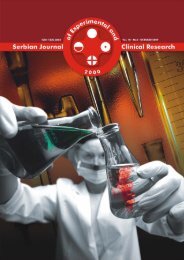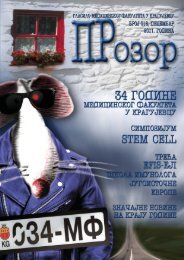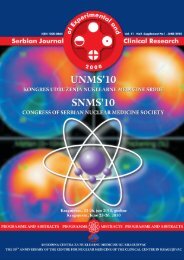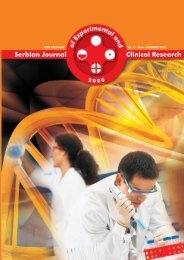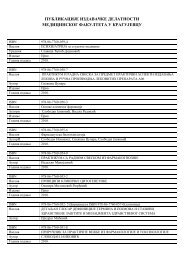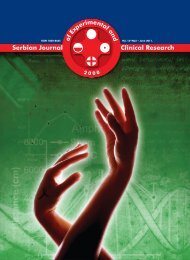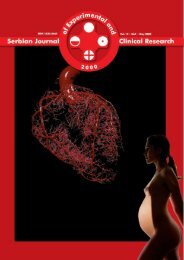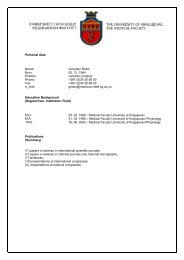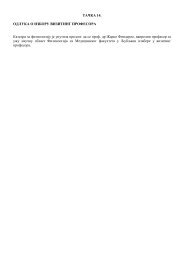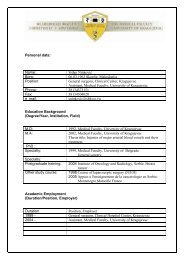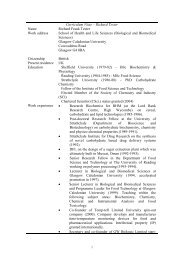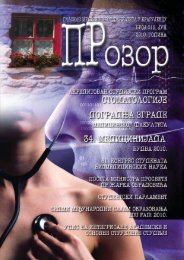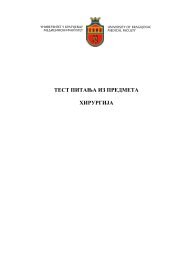neurotoxicity and mechanisms of induced hyperexcitability
neurotoxicity and mechanisms of induced hyperexcitability
neurotoxicity and mechanisms of induced hyperexcitability
Create successful ePaper yourself
Turn your PDF publications into a flip-book with our unique Google optimized e-Paper software.
sisted <strong>of</strong> consecutive interruptions <strong>of</strong> at least four beamswithin a period <strong>of</strong> 500 ms. Small, repetitive beam breakswithin a virtual box <strong>of</strong> 4 x 4 beams around the rat wererecorded as stereotypic counts. Recordings <strong>of</strong> photocellbeam interruptions by the rat were taken every 5 min<strong>and</strong> stored by the computer s<strong>of</strong>tware. Three locomotoractivity tests were done after treatment with saline, 0.5mg/kg <strong>of</strong> amphetamine or 2.5 mg/kg <strong>of</strong> phencyclidine administeredin a r<strong>and</strong>om order. These locomotor activitytests were done with three to four day intervals to preventhabituation due to repeated testing <strong>and</strong> to allow forclearance <strong>of</strong> the drugs. Prior to any drug manipulation,the rats were placed in the locomotor photocell cages for30 min to establish baseline locomotor activity <strong>and</strong> allowfor habituation to the test environment. After 30 min <strong>of</strong>spontaneous baseline activity, the rats were injected <strong>and</strong>locomotor activity was recorded over a further 90 min,generating a total session time <strong>of</strong> two hours. For the purpose<strong>of</strong> this paper, locomotor activity data were expressedas cumulative data from 30 min periods <strong>and</strong> presented asa time course <strong>of</strong> distance moved during the 30 min beforeinjection <strong>and</strong> 90 min after injection.After locomotor activity experiments, rats were testedfor prepulse inhibition. This was done using six automatedstartle chambers (SR-LAB, San Diego Instruments, SanDiego, CA, USA) consisting <strong>of</strong> clear Plexiglas cylinders, 9cm in diameter, resting on a platform inside a ventilated,sound-attenuated <strong>and</strong> illuminated chamber. A speakermounted 24 cm above the cylinder produced both continuousbackground noise at 70 dB <strong>and</strong> the various acousticstimuli. Whole-body startle responses <strong>of</strong> the animal in responseto acoustic stimuli caused vibrations <strong>of</strong> the Plexiglascylinder, which were then converted into quantitativeresponses by a piezoelectric accelerometer unit attachedbeneath the platform. The percent prepulse inhibition wascalculated as 100 x {[pulse-alone trials – (prepulse + pulsetrials )] /(pulse-alone trials)} [31]. At least one day beforethe prepulse inhibition testing, rats underwent a pretestsession where they were exposed to the testing cylinders<strong>and</strong> the testing protocol for the first time. This session wasconducted to allow rats to habituate to the testing environment.Each rat was placed into the chamber for a 5 minacclimation period with a 70 dB background noise levelthat continued throughout the session. A single prepulseinhibition session lasted for about 45 min <strong>and</strong> consisted<strong>of</strong> high- <strong>and</strong> low-intensity stimulus combinations with acontinuous background noise <strong>of</strong> 70 dB. The session started<strong>and</strong> ended with a block <strong>of</strong> ten pulse-alone trials <strong>of</strong> 115dB. These blocks, together with twenty pseudo-r<strong>and</strong>omlypresented pulse-alone trials during the prepulse inhibitionprotocol, were used to calculate the basal startle reactivity<strong>and</strong> startle habituation. Prepulses were presented for 20 ms<strong>and</strong> differed in intensity. Prepulse inhibition was assessedby the r<strong>and</strong>om presentation <strong>of</strong> 115 dB pulses, ten each <strong>of</strong>prepulse-2, -4, -8, 12 <strong>and</strong> –16 <strong>and</strong> ten ‘no-stimulus’ trials.For example, prepulse-8 (PP8) is a 20-ms prepulse <strong>of</strong> 8 dBabove the background noise, i.e., 78 dB, followed 100 mslater by a 40-ms 115 dB pulse [58]. The interval betweentrials varied (10 - 37 s) to prevent conditioning <strong>of</strong> the responses.A microcomputer <strong>and</strong> an interface assembly thatcontrolled the delivery <strong>of</strong> acoustic stimuli digitised <strong>and</strong> recordedthe readings.Tissue preparation for histology <strong>and</strong> high pressureliquid chromatography (HPLC)At the end <strong>of</strong> the experiments, rats were killed by decapitation<strong>and</strong> the brains were removed from the skull.The brains were placed on a cold plate. First, the frontalcortex was dissected bilaterally [59], <strong>and</strong> then the mPFCwas dissected out. For the histological assessment <strong>of</strong> thelocation <strong>of</strong> the injection sites, 20-μm-thick sections <strong>of</strong> themedial prefrontal cortex <strong>of</strong> two mPFC-lesioned rats werecut on a cryostat <strong>and</strong> mounted onto gelatin-coated glassslides. The sections were then stained with cresyl violet(ProSciTech, Thuringowa, QLD, Australia) <strong>and</strong> examinedmicroscopically to verify the location <strong>of</strong> the tips <strong>of</strong> theinfusion cannulas.The HPLC measurements <strong>of</strong> the tissue serotonin (5-HT)concentration were carried out in 23 animals. The dissectedstructures were weighed <strong>and</strong> stored in Eppendorf tubes at–80°C until the biochemical assays were performed. The tissuesamples were homogenised in 500 μl <strong>of</strong> 0.1 M perchloricacid by ultrasonication <strong>and</strong> centrifuged at 15,500 g for 5min. A 50 μl aliquot <strong>of</strong> the supernatant was injected into ahigh pressure liquid chromatography (HPLC) system to determinethe content <strong>of</strong> 5-HT (ng/mg tissue <strong>of</strong> wet weight).The HPLC system consisted <strong>of</strong> a Waters Model 510 Solventdelivery system, a Waters U6K injector, an Alphabond C18125A 10 U 150* 3.9 mm column <strong>and</strong> a Column & Spectra-Physics 970 D-A1 fluorescence spectrometer. The outputsignal from the fluorescence detector was analysed with thechromatography s<strong>of</strong>tware package, 810 Baseline, version3.31. The mobile phase used consisted <strong>of</strong> 9.8 g/l KH 2PO 4, 1.0g/l Na 2EDTA, 5% acetonitrile <strong>and</strong> 1 ml/l triethylamine. ThepH <strong>of</strong> the mobile phase solution was adjusted to 3.0 with 1M HCl. Subsequently, the solution was filtered <strong>and</strong> degassed<strong>and</strong> delivered to the HPLC at a flow rate <strong>of</strong> 1 ml/min. Priorto sample testing, the following st<strong>and</strong>ards for 5-HT were runthrough the system: 12.5 ng/ml, 25 ng/ml, 50 ng/ml, 100 ng/ml <strong>and</strong> 200 ng/ml. Calibration curves were constructed, <strong>and</strong>the level <strong>of</strong> 5-HT in tissue samples was calculated relativeto these st<strong>and</strong>ards. Each run lasted 8 min <strong>and</strong> the retentiontime for serotonin was 2.6 min.Statistical analysisData were expressed as the mean ± the st<strong>and</strong>ard error<strong>of</strong> the mean (SEM). All <strong>of</strong> the statistical analyses were performedusing the statistical s<strong>of</strong>tware package SYSTAT 9.0(SPSS Inc., Chicago, IL, USA). All <strong>of</strong> the data were analysedusing an analysis <strong>of</strong> variance (ANOVA) with repeatedmeasures where appropriate. In the locomotor activity experiments,data were summed in 30-min blocks, <strong>and</strong> theseblocks were used to assess the main effects <strong>of</strong> the lesiontype (group), the treatment with amphetamine or phency-14



